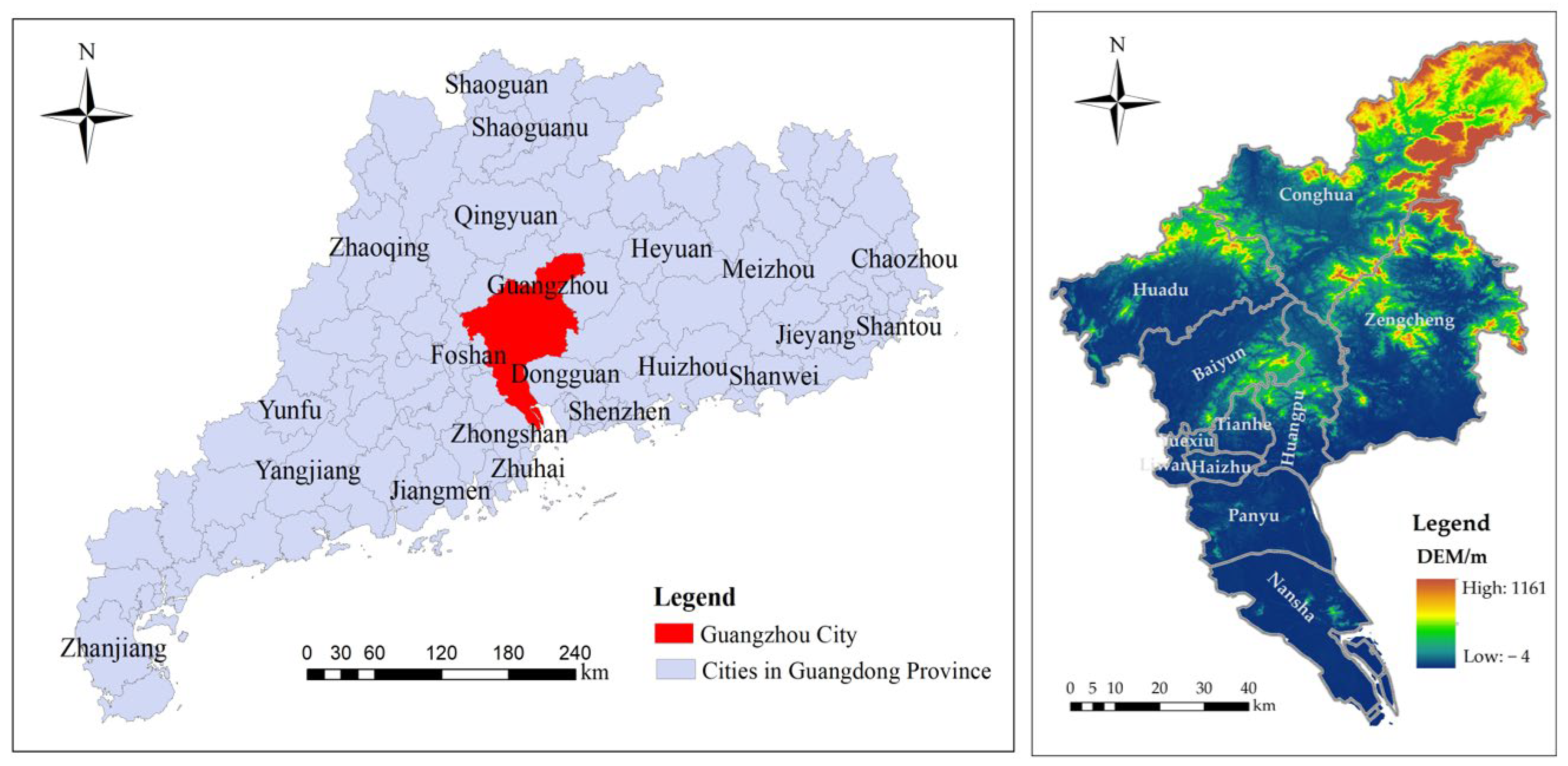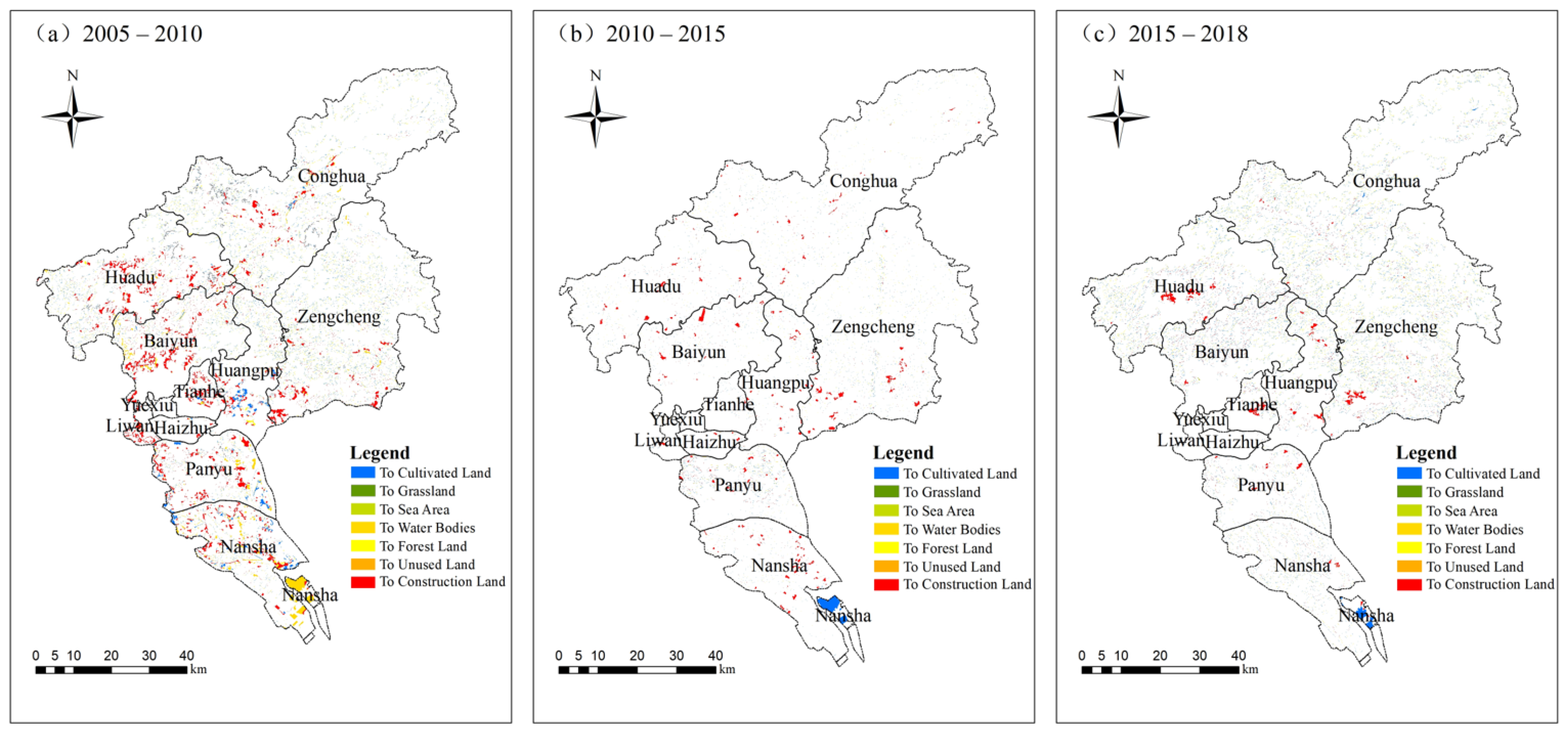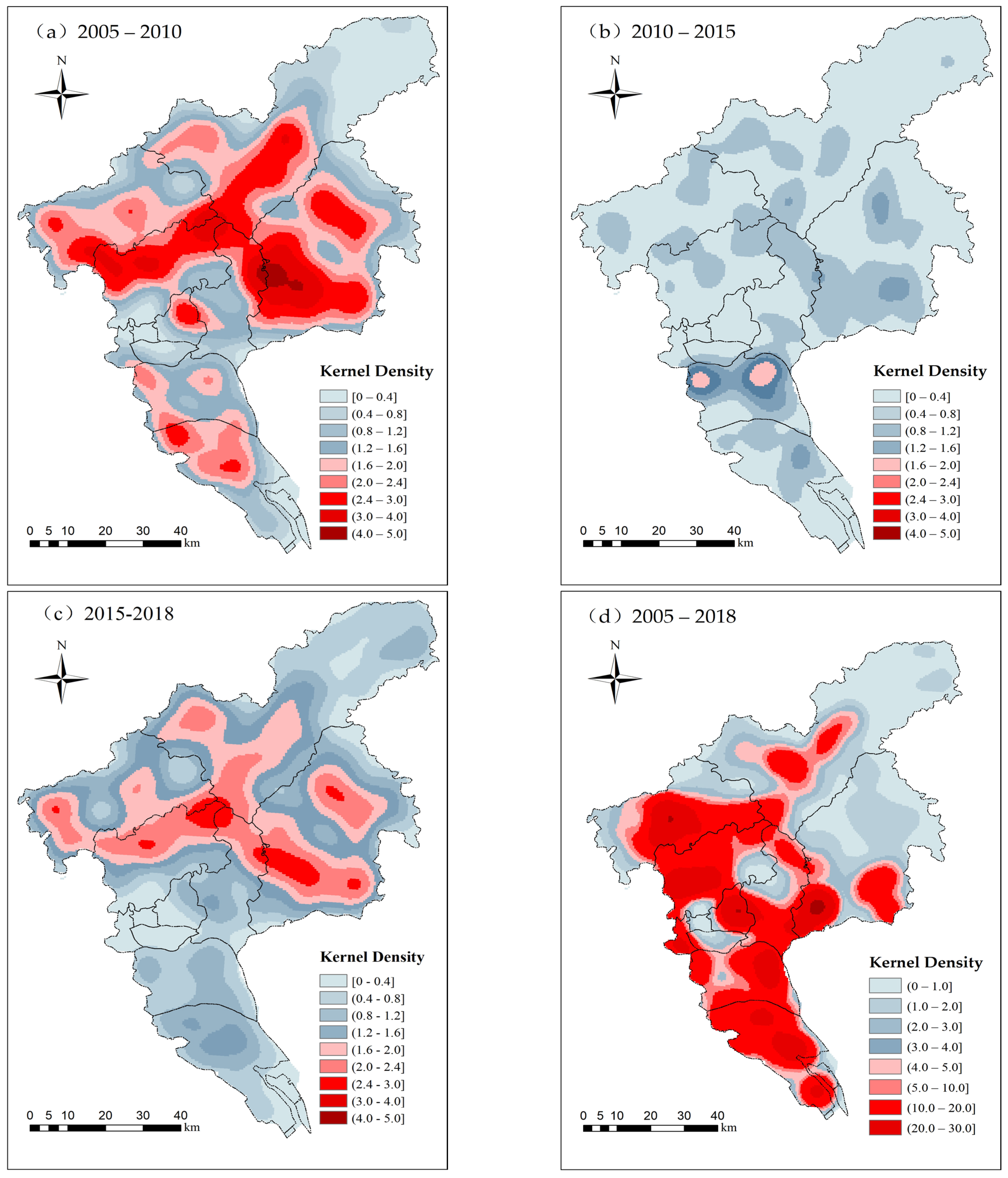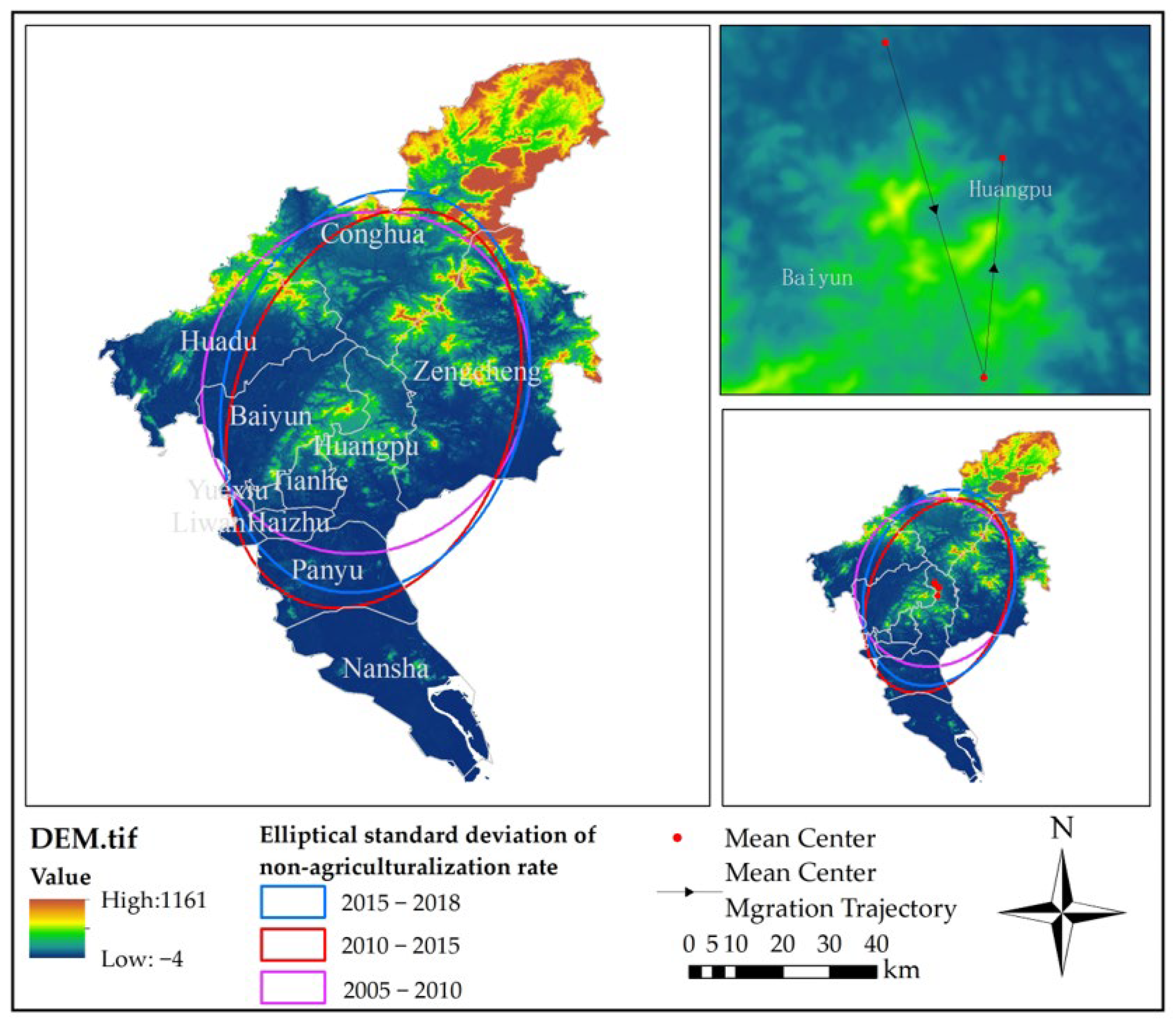Analysis of the Evolution of Non-Agriculturization Arable Land Use Pattern and Its Driving Mechanisms
Abstract
1. Introduction
2. Study Area, Data, and Methods
2.1. Study Area
2.2. Data Source and Processing
2.3. Research Method
2.3.1. Non-Agricultural Rate
2.3.2. Kernel Density Estimation
2.3.3. Gravity Center Model
2.3.4. Standard Deviation Elliptical Model
2.3.5. Model Selection and Evaluation
3. Results
3.1. Analysis of the Change in Non-Agricultural Types of Cultivated Land in Different Stages
3.2. Kernel Density Analysis of Non-Agriculturization of Arable Land Use
3.3. Migration of Non-Agriculturization Gravity in Guangzhou’s Arable Land Use
3.4. Analysis of Driving Factors of Arable Land Non-Agriculturization
4. Discussion
4.1. Changes in the Temporal Dynamics of Farmland Conversion to Non-Agriculturization Use
4.2. Spatial Pattern Changes in Farmland Conversion to Non-Agriculturization Uses
4.3. Analysis of the Driving Mechanisms of Farmland Conversion to Non-Agriculturization Uses
5. Conclusions
Author Contributions
Funding
Data Availability Statement
Acknowledgments
Conflicts of Interest
References
- Guo, C.; Jin, X.; Yang, X.; Xu, W.; Sun, R.; Zhou, Y. Comprehensive evaluation of newly cultivated land sustainable utilization at project scale: A case study in Guangdong, China. J. Geogr. Sci. 2024, 34, 745–762. [Google Scholar] [CrossRef]
- Ma, Y.; Wang, X.; Zhong, C. Spatial and Temporal Differences and Influencing Factors of Eco-Efficiency of Cultivated Land Use in Main Grain-Producing Areas of China. Sustainability 2024, 16, 5734. [Google Scholar] [CrossRef]
- Hu, Y.; Yang, H.; Zou, R.; Shi, Z.; Wu, W.; Wu, L.; Wang, L.; Ren, X.; Xie, Y.; Ren, S.; et al. Evolution and prospect of systematic cognition on the cultivated land resources. J. Agric. Resour. Environ. 2021, 38, 937–945. [Google Scholar]
- Wu, Z.; Fan, Q.; Li, W.; Zheng, Y. The Spatial–Temporal Evolution and Impact Mechanism of Cultivated Land Use in the Mountainous Areas of Southwest Hubei Province, China. Land 2024, 13, 1946. [Google Scholar] [CrossRef]
- Chen, F.; Liu, J.; Chang, Y.; Zhang, Q.; Yu, H.; Zhang, S. Spatial Pattern Differentiation of Non-grain Cultivated Land and Its Driving Factors in China. China Land Sci. 2021, 35, 33–43. [Google Scholar]
- General Office of the State Council. The General Office of the State Council issued the Notice on Resolutely stopping the “Non-agricultural” behavior of cultivated land. Agric. Eng. 2020, 10, 3. [Google Scholar]
- Yang, Y.; Peng, B.; Lv, M.; Chen, X.; Guo, X. Spatial and temporal changes and driving mechanism of cultivated land conversion in central Yunnan urban agglomeration from 1990 to 2020. J. Soil Water Conserv. 2024, 38, 239–251. [Google Scholar]
- Liu, H.; Wang, H.; Jin, Z.; Pan, C. Spatial and temporal evolution characteristics and driving mechanism of cultivated land conversion in Lower Liaohe River Plain. Chin. J. Eco-Agric. 2024, 32, 1420–1431. [Google Scholar]
- Su, Y. Study on the Spatial-Temporal Evolution and Control of Non-Grain Production within Cultivated Land. Ph.D. Thesis, Zhejiang University, Hangzhou, China, 2020. [Google Scholar]
- Kong, X. To stop the “non-agricultural transformation” of cultivated land, we must enhance the collaborative governance capacity. J. China Party Gov. Cadres Forum 2020, 81–82. [Google Scholar] [CrossRef]
- Hiroyoshi, Y. A study on the operational problems of the use district system from the viewpoint of the change of land use: The case of industrial districts in the built up area. J. City Plan. 1983, 18, 85–90. [Google Scholar]
- Prasetyolli, B.; Jitsukumasaki, R. Population growth and land use change in tropical urban areas: A case study of jabotabek metropolitan area. Indones. J. Jpn. For. Soc. 1995, 77, 72–74. [Google Scholar]
- Walford, R. Land use changes across the century. Teach. Geogr. 2000, 25, 40–41. [Google Scholar]
- Leitch, C.; Harbor, J. Impacts of land use change on freshwater runoff into the near-coastal zone, Holetown Watershed, Barbados: Comparisons of long-term to single-storm effects. J. Soil Water Conserv. 1999, 54, 584–592. [Google Scholar] [CrossRef]
- Zhang, Q.; Xu, H.; Fu, J.; Yu, P.; Zhang, P. Spatial Analysis of Land Use and Land Cover Changes in Recent 30 Years in Manas River Basin. Procedia Environ. Sci. 2012, 12, 906–916. [Google Scholar]
- Peng, P.; Yang, G. Agricultural development and non-agriculturization of land. Nat. Resour. J. 1996, 20, 36–40. [Google Scholar]
- Zhang, K. Thoughts on China’s urbanization and urbanization. Urban Probl. J. 1995, 14, 36–38. [Google Scholar]
- Lu, M. New trend of development economics: Theoretical research on rural non-agricultural chemistry. Econ. Dyn. J. 1994, 35, 50–53. [Google Scholar]
- Liu, J.; Su, B. Empirical analysis of urbanization and rural non-agriculture in Xinjiang. Xinjiang Econ. J. 1994, 13, 12–15. [Google Scholar]
- Jiang, C. Dynamic investigation of the differentiation of farmers (farmers) in the process of rural non-agricultural chemical-Take Tianchang City, Anhui Province as an example. Chin. Rural Econ. J. 1995, 11, 50–56. [Google Scholar]
- Tang, H.; Guo, X.; Shen, M. Investigation and analysis of the current non-agricultural problems of agricultural land. Issues Agric. Econ. J. 1993, 14, 45–50. [Google Scholar]
- Zhao, Y. Comparative study on the mechanism of non-agricultural development in China-Take quantitative analysis in Liaoning and Jiangsu provinces as an example. Urban Plan. J. 1996, 40, 45–49. [Google Scholar]
- Long, Z.; Sheng, Z. On the Non-agriculturalization of Farmland in China. Ecol. Econ. J. 2004, 11, 49–51. [Google Scholar]
- Liu, Z. Comparative Analysis of Reasons for Rural Non-agriculturalization. Gansu Theory Res. J. 1997, 17, 42–44. [Google Scholar]
- Min, J.; Gao, W.; Li, X.; Zhang, A. An Analysis of Dissimilarity in Space of Cultivated Land Conversion in Jianghan Plain. Sci. Technol. Manag. Land Resour. J. 2006, 23, 11–15. [Google Scholar]
- Yan, X.; Liu, X. Analysis of rural urbanization characteristics in the Pearl River Delta. Geogr. Land Res. J. 1997, 13, 30–36. [Google Scholar]
- Liu, L. Study on the Convergence of Cultivated Land Conversion in Economic Growth. Master’s Thesis, Chinese Academy of Agricultural Sciences, Beijing China, 2007. [Google Scholar]
- Yang, R. Association analysis of Chinese urbanization and non-agricultural gray. Reg. Res. Dev. 1998, 17, 18–20. [Google Scholar]
- Fan, J.; Tian, M. Relative Analysis and Provincial Differences of China′s Urbanization and Non-agricultural Development. Geogr. Sci. 2003, 23, 641–648. [Google Scholar]
- Tan, R.; Qu, F. Spatial allocation efficiency of farmland Coversion and Farmland Resource Loss in China. China Soft Sci. 2006, 21, 49–57. [Google Scholar]
- Ren, P.; Wu, T.; Zhou, J. Study on Value Loss Evaluation Model and Compensation Mechanism of Cultivated Land Conversion. Sci. Agric. Sin. 2014, 47, 786–795. [Google Scholar]
- Qu, F.; Wu, L. Kuznets curve hypothesis and verification of economic growth and nonagroalization of cultivated land. Resour. Sci. 2004, 28, 61–67. [Google Scholar]
- Yang, W.; Liu, D. Estimation Loss of Agroecosystem Service Value in Farmland Conversion land Its Provincial Difference in 2001–2016. Econ. Geogr. 2019, 39, 201–209. [Google Scholar]
- Gong, R. Agricultural High-Quality Development and New Urbanization in China: Space-Time Evolution and Interactive Relationship. Ph.D. Thesis, Chongqing University, Chongqing, China, 2022. [Google Scholar]
- Zhen, F.; Cao, Y.; Qin, X.; Wang, B. Delineation of an urban agglomeration boundary based on Sina Weibo microblog ’check-in’ data: A case study of the Yangtze River Delta. Cities 2017, 60, 180–191. [Google Scholar] [CrossRef]
- Li, H.; Tian, D.; Tan, J. Spatial-temporal Pattern Evolution and Influencing Factors of Cultivated Land Non-agriculturalization in Yanan City. Bull. Soil Water Conserv. 2022, 42, 330–337. [Google Scholar]
- Xing, L.; Fang, B. Study on So-temporal Pattern and Coordinated Development of Urbanization and Ecological Environment in Jiangsu Province. J. Nanjing Norm. Univ. (Nat. Sci. Ed.) 2018, 41, 131–137. [Google Scholar]
- Li, X.; Wu, Q.; Liu, D. Spatial Distribution and Influential Factor of Agricultural Tourism Destinations in Wuhan Metropolitan Area. Trop. Geogr. 2014, 34, 422–428. [Google Scholar]
- Li, X.; Wu, L.; Wu, Q.; Zhang, M. The Space-Temporal Pattern Evolution of China’s National Ecological Demonstration Areas. Econ. Geogr. 2015, 35, 149–156. [Google Scholar]
- Liang, Y.; Guan, Y.; Huang, Z.; Jiao, X. Spatial-Temporal Heterogeneity of Coupling and Coordination Between Green Land Use and E-conomic Growth in Beijing-Tianjin-Hebei Area. J. Ecol. Rural Environ. 2020, 36, 1522–1531. [Google Scholar]
- Zhang, Y.; Wang, L.; Zhang, H.; Li, X. An Analysis on Land Use Changes and Their Driving Factors in Shule River: An Example From Anxi County. Prog. Geogr. 2003, 22, 170–178. [Google Scholar]
- Zhu, Z. Study on the Spatial-Temporal Characteristics, Driving Mechanisms, and Optimization Regulation of Cultivated Land Use Transformation in China’s Main Grain-Producing Areas. Ph.D. Thesis, Northwest A & F University, Yangling, China, 2024. [Google Scholar]
- Zhou, F.; Zhou, Y. Analysis of the factors influencing the quantity and quality of cultivated land in Xishan City, Jiangsu Province. China Land Sci. 2001, 15, 7–10. [Google Scholar]
- Cao, L.; Lang, Q.; Lei, K.; Wang, D.; Yang, K. Analysis on landscape pattern dynamics and driving force in Yongding River Basin from 1980 to 2020. J. Environ. Eng. Technol. 2023, 13, 143–153. [Google Scholar]
- Deng, L.; Yang, Z.; Su, W. Optimization Countermeasures for Crops Planting Structure in Karst Area of Guizhou. Econ. Geogr. 2017, 37, 160–166. [Google Scholar]
- Huang, L.; Zhang, J.; Lu, S.; Zhong, L.; Liu, L.; Gong, H.; Chao, L.; Huang, T.; Gan, L. Spatial-temporal Patterns and Driving Factors of Crop Planting Structure in Guangxi. Southwest China J. Agric. Sci. 2021, 34, 1682–1689. [Google Scholar]
- Ke, S.; Zhu, X.; Cui, H.; Yu, Y.; Hu, L.; Lu, X.; Gao, T. Impact of China’s overseas farmland investment on host countries’ environmental quality and itstransmission mechanisms. China Popul. Resour. Environ. 2024, 34, 75–84. [Google Scholar]
- Li, J.; Qie, R. Spatial Differentiation and Driving Factors of Rural Idle Homestead in Northeast Black Soil Region: A Case Study ofMeihekou City, Jilin Province. T. Nat. Resour. Stud. 2025, 47, 34–38. [Google Scholar]
- Wu, N.; Wei, Y.; Li, L.; Yang, H. Spatial distribution of non-grain crops and formation mechanism: Empirical analysis of Ningling County, Henan Province. Prog. Geogr. 2023, 42, 1298–1310. [Google Scholar] [CrossRef]
- Huang, Z.; Li, Y.; Mao, X. The current situation and countermeasures of “non-agricultural” and “non-food” cultivated land in China. JAC Forum 2022, 65, 13–21. [Google Scholar]
- Jiao, Y.; Xiao, D.; Ma, M. Spatial pattern in residential area and influencing factors in oasis landscape. Acta Ecol. Sin. 2003, 23, 2092–2100. [Google Scholar]
- Lu, Q.; Zhu, S.; Xiao, Z.; Zhu, G.; Li, J.; Gui, J.; He, W.; Sun, J. Spatiotemporal Variability and Drivers of Cropland Non-Agricultural Conversion Across Mountainous County Types: Evidence from the Qian-Gui Karst Region, China. Agriculture 2025, 15, 795. [Google Scholar] [CrossRef]
- Xijiri; Zhou, R.; Bao, B.; Burenjirigala. Spatiotemporal patterns and drivers of cultivated land conversion in Inner Mongolia Autonomous Region, northern China. J. Arid Land 2024, 16, 1197–1213. [Google Scholar] [CrossRef]
- Wu, X.; Zhao, N.; Wang, Y.; Zhang, L.; Wang, W.; Liu, Y. Cropland non-agriculturalization caused by the expansion of built-up areas in China during 1990–2020. Land Use Policy 2024, 146, 107312. [Google Scholar] [CrossRef]
- Yan, H.; Chen, H.; Wang, F.; Qiu, L. Dynamics of Cropland Non-Agriculturalization in Shaanxi Province of China and Its Attribution Using a Machine Learning Approach. Land 2025, 14, 190. [Google Scholar] [CrossRef]
- Huang, H.; Zhu, H. Analysis on the Cultivated Land Quantity Change and Its Driving Forces in Chengdu Plain. J. Anhui Agric. Sci. 2010, 38, 843–845. [Google Scholar]
- Yuan, S.; Yang, L.; Yang, G.; Yao, S. The Spatial Heterogeneity of Socio-economic Driving Factors of Cultivated Land Conversion:A Case Based on STIRPAT and GWR models. Econ. Geogr. 2013, 33, 137–143. [Google Scholar]
- Zhang, Z.; Ghazali, S.; Miceikienė, A.; Zejak, D.; Choobchian, S.; Pietrzykowski, M.; Azadi, H. Socio-economic impacts of agricultural land conversion: A meta-analysis. Land Use Policy 2023, 132, 106831. [Google Scholar] [CrossRef]







| Driving Factors | Driver Factor | Source of Indicators/ Calculation Method | Index Interpretation |
|---|---|---|---|
| Natural Factors of Cultivated Land | Arable Land Quality | Arable land quality data | Reflect the natural productivity of arable land |
| Precipitation | Calculate the regional average based on meteorological station data | Reflect the actual utilization of arable land | |
| Elevation | Calculate elevation values based on DEM (Digital Elevation Model) | Reflect the basic characteristics of the terrain | |
| Per Capita Cultivated Land Area | Statistical data (cultivated land area/population) × 1000 | Reflect the arable land resource potential for crop cultivation | |
| Socio-economic Development | Total Agricultural Machinery Power | Statistical data | Reflect the degree of mechanization in crop cultivation |
| Gross Domestic Product | Statistical data | Reflect the level of economic development in the region | |
| Per Capita Net Income of Rural Residents | Statistical data | Reflect the per capita net income level of rural residents in the region | |
| Gross Value of the Secondary Industry | Statistical data | Reflect the level of industrial development in the regional industrial structure | |
| Gross Value of the Tertiary Industry | Statistical data | Reflect the level of service industry development in the regional industrial structure | |
| Population Density | Urban population/total population | Reflect the pressure of population on land use |
| Districts | Grassland | Construction Land | Arable Land | Forest Land | Water Area | Unused Land | Total Arable Land Area | Non-Agriculturization Land Area | Non-Agriculturization Rate |
|---|---|---|---|---|---|---|---|---|---|
| Baiyun | 4.87 | 3645.89 | 18,821.15 | 402.65 | 813.22 | 23,687.77 | 4866.62 | 20.54 | |
| Conghua | 150.22 | 1947.27 | 47,243.03 | 1711.18 | 388.07 | 2.01 | 51,441.79 | 4198.76 | 8.16 |
| Panyu | 7.95 | 2705.48 | 15,067.48 | 82.00 | 904.10 | 18,767.02 | 3699.54 | 19.71 | |
| Haizhu | 117.86 | 182.66 | 4.05 | 15.70 | 320.27 | 137.61 | 42.97 | ||
| Huadu | 79.37 | 3782.25 | 29,244.31 | 525.92 | 625.61 | 3.22 | 34,260.68 | 5016.37 | 14.64 |
| Huangpu | 3.00 | 1163.48 | 7207.74 | 603.13 | 22.35 | 8999.70 | 1791.95 | 19.91 | |
| Liwan | 793.77 | 210.28 | 16.50 | 1020.56 | 810.28 | 79.40 | |||
| Nansha | 15.23 | 2775.78 | 31,405.59 | 215.54 | 3908.27 | 38,320.42 | 6914.82 | 18.04 | |
| Tianhe | 1077.48 | 1290.46 | 68.83 | 6.84 | 2443.61 | 1153.15 | 47.19 | ||
| Zengcheng | 15.39 | 2665.49 | 45,155.59 | 1845.41 | 476.12 | 50,157.99 | 5002.40 | 9.97 |
| Districts | Grass Land | Construction Land | Arable Land | Forest Land | Water Area | Unused Land | Total Arable Land Area | Non-Agriculturization Land Area | Non-Agriculturization Rate |
|---|---|---|---|---|---|---|---|---|---|
| Baiyun | 0.45 | 667.58 | 19,346.03 | 44.82 | 37.52 | 20,096.41 | 750.38 | 3.73 | |
| Conghua | 21.77 | 572.32 | 49,062.05 | 315.46 | 15.65 | 0.54 | 49,987.79 | 925.74 | 1.85 |
| Panyu | 9.54 | 634.73 | 16,218.39 | 47.10 | 183.33 | 17,093.09 | 874.70 | 5.12 | |
| Haizhu | 85.20 | 134.78 | 6.75 | 2.25 | 228.98 | 94.20 | 41.14 | ||
| Huadu | 11.79 | 731.20 | 30,515.82 | 75.45 | 51.82 | 0.63 | 31,386.70 | 870.88 | 2.77 |
| Huangpu | 0.36 | 538.00 | 8524.24 | 71.15 | 3.97 | 9137.73 | 613.49 | 6.71 | |
| Liwan | 80.34 | 161.83 | 2.42 | 244.59 | 82.76 | 33.83 | |||
| Nansha | 0.18 | 953.33 | 34,012.67 | 10.08 | 81.43 | 35,057.69 | 1045.02 | 2.98 | |
| Tianhe | 33.73 | 1419.72 | 4.77 | 0.63 | 1458.84 | 39.13 | 2.68 | ||
| Zengcheng | 4.77 | 1289.56 | 46,488.04 | 400.09 | 49.40 | 48,231.86 | 1743.82 | 3.62 |
| Districts | Grass Land | Construction Land | Arable Land | Forest Land | Water Area | Unused Land | Total Arable Land Area | Non-Agriculturization Land Area | Non-Agriculturization Rate |
|---|---|---|---|---|---|---|---|---|---|
| Baiyun | 18.08 | 540.22 | 18,389.94 | 260.40 | 302.42 | 19,511.07 | 1121.13 | 5.75 | |
| Conghua | 166.09 | 539.49 | 46,978.78 | 1656.76 | 111.16 | 0.09 | 49,452.36 | 2473.58 | 5.00 |
| Panyu | 3.96 | 470.82 | 15,961.81 | 45.99 | 174.21 | 16,656.78 | 694.97 | 4.17 | |
| Haizhu | 5.76 | 140.89 | 2.43 | 2.43 | 151.51 | 10.62 | 7.01 | ||
| Huadu | 76.39 | 1422.17 | 28,403.81 | 482.98 | 348.10 | 5.67 | 30,739.12 | 2335.31 | 7.60 |
| Huangpu | 3.69 | 695.70 | 7561.38 | 348.36 | 18.16 | 8627.30 | 1065.91 | 12.36 | |
| Liwan | 6.98 | 165.48 | 1.00 | 173.45 | 7.97 | 4.60 | |||
| Nansha | 1.17 | 381.84 | 35,119.02 | 33.92 | 358.20 | 35,894.14 | 775.12 | 2.16 | |
| Tianhe | 553.36 | 847.65 | 33.10 | 4.95 | 1439.06 | 591.41 | 41.10 | ||
| Zengcheng | 18.71 | 1217.94 | 43,795.01 | 1782.23 | 259.79 | 47,073.69 | 3278.68 | 6.96 |
| Standard Deviation Ellipse | Centroid Position | Migration Distance (km) | Long Axis (km) | Short Axis (km) | Long-to-Short Axis Ratio | Azimuth (°) | Ellipse Area (ha) |
|---|---|---|---|---|---|---|---|
| 2005–2010 non-agriculturization Rate | 113°30.12′ E 23°20.557′ N | - | 3.72 | 3.42 | 1.10 | 29.18 | 4.00 |
| 2010–2015 non-agriculturization Rate | 113°30.802′ E 23°17.454′ N | 5.81 | 4.40 | 2.97 | 1.48 | 19.44 | 4.10 |
| 2015–2018 non-agriculturization Rate | 113°31.167′ E 23°19.424′ N | 3.67 | 4.37 | 3.21 | 1.36 | 14.93 | 4.40 |
| Stage | Driver Factor | Regression Coefficient | 95% CI | Collinearity Diagnostics | R2 | F Value | |
|---|---|---|---|---|---|---|---|
| VIF | Tolerance | ||||||
| 2005–2010 | Constant | −6.392 | −21.704~8.920 | - | - | 0.871 | F (2,8) = 26.919 p = 0.000 |
| (−0.818) | |||||||
| Population Density (Person/km2) | 0.003 ** | 0.002~0.004 | 1.053 | 0.95 | |||
| −7.264 | |||||||
| Per Capita Annual Net Income of Rural Residents (Yuan) | 0.001 * | 0.000~0.002 | 1.053 | 0.95 | |||
| −2.635 | |||||||
| 2010–2015 | Constant | 1.172 | 0.267~2.077 | - | - | 0.895 | F (1,5) = 42.491 p = 0.001 |
| −2.537 | |||||||
| Gross Domestic Product (Billion Yuan) | 0.000 ** | 0.000~0.000 | 1 | 1 | |||
| −6.519 | |||||||
| 2015–2018 | Constant | −9.137 * | −15.624~−2.649 | - | - | 0.927 | F (3,6) = 25.437 p = 0.001 |
| (−2.760) | |||||||
| Gross Domestic Product (Billion Yuan) | 0.011 ** | 0.008~0.013 | 1.594 | 0.627 | |||
| −8.492 | |||||||
| Tertiary Industry (Billion Yuan) | −0.008 * | −0.013~−0.003 | 1.173 | 0.852 | |||
| (−3.294) | |||||||
Disclaimer/Publisher’s Note: The statements, opinions and data contained in all publications are solely those of the individual author(s) and contributor(s) and not of MDPI and/or the editor(s). MDPI and/or the editor(s) disclaim responsibility for any injury to people or property resulting from any ideas, methods, instructions or products referred to in the content. |
© 2025 by the authors. Licensee MDPI, Basel, Switzerland. This article is an open access article distributed under the terms and conditions of the Creative Commons Attribution (CC BY) license (https://creativecommons.org/licenses/by/4.0/).
Share and Cite
Zhang, Y.; Wang, Q.; Hu, Y.; Wang, W.; Mao, X. Analysis of the Evolution of Non-Agriculturization Arable Land Use Pattern and Its Driving Mechanisms. Land 2025, 14, 968. https://doi.org/10.3390/land14050968
Zhang Y, Wang Q, Hu Y, Wang W, Mao X. Analysis of the Evolution of Non-Agriculturization Arable Land Use Pattern and Its Driving Mechanisms. Land. 2025; 14(5):968. https://doi.org/10.3390/land14050968
Chicago/Turabian StyleZhang, Ying, Qiang Wang, Yueming Hu, Wei Wang, and Xiaoyun Mao. 2025. "Analysis of the Evolution of Non-Agriculturization Arable Land Use Pattern and Its Driving Mechanisms" Land 14, no. 5: 968. https://doi.org/10.3390/land14050968
APA StyleZhang, Y., Wang, Q., Hu, Y., Wang, W., & Mao, X. (2025). Analysis of the Evolution of Non-Agriculturization Arable Land Use Pattern and Its Driving Mechanisms. Land, 14(5), 968. https://doi.org/10.3390/land14050968









